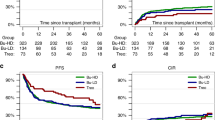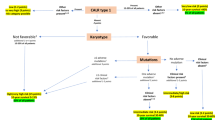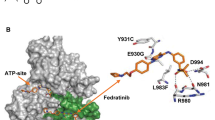Abstract
Myeloproliferative neoplasm (MPN)-associated myelofibrosis is a MPN characterized by bone marrow fibrosis, cytopenias, splenomegaly and constitutional symptoms. Pomalidomide, an immune-modifying drug, is reported to improve anaemia and thrombocytopenia in some patients with MPN-associated myelofibrosis. We designed a phase 2 study of pomalidomide in patients with MPN-associated myelofibrosis and anaemia and/or thrombocytopenia and/or neutropenia. Subjects received pomalidomide 2.0 mg/day in cohort 1 (n=38) or 0.5 mg/day in cohort 2 (n=58). Prednisolone was added if there was no response after 3 months in cohort 1 and based on up-front randomization in cohort 2 if there was no response at 3 or 6 months. Response rates were 39% (95% confidence interval (CI), 26–55%) in cohort 1 and 24% (95% CI, 15–37%) in cohort 2. In a multivariable logistic regression model pomalidomide at 2.0 mg/day (odds ratio (OR), 2.62; 95% CI, 1.00–6.87; P=0.05) and mutated TET2 (OR, 5.07; 95% CI, 1.16–22.17; P=0.03) were significantly associated with responses. Median duration of responses was 13.0 months (range 0.9–52.7). There was no significant difference in response rates or duration in subjects receiving or not receiving prednisolone. Clinical trial MPNSG 01-09 is registered at ClinicalTrials.gov (NCT00949364) and clinicaltrialsregister.eu (EudraCT Number: 2009-010738-23)
This is a preview of subscription content, access via your institution
Access options
Subscribe to this journal
Receive 12 print issues and online access
$259.00 per year
only $21.58 per issue
Buy this article
- Purchase on Springer Link
- Instant access to full article PDF
Prices may be subject to local taxes which are calculated during checkout



Similar content being viewed by others
References
Bartlett JB, Dredge K, Dalgleish AG . The evolution of thalidomide and its IMiD derivatives as anticancer agents. Nat Rev Cancer 2004; 4: 314–322.
Gowin KL, Mesa RA . Profile of pomalidomide and its potential in the treatment of myelofibrosis. Ther Clin Risk Manag 2015; 11: 549–556.
Galustian C, Meyer B, Labarthe MC, Dredge K, Klaschka D, Henry J et al. The anti-cancer agents lenalidomide and pomalidomide inhibit the proliferation and function of T regulatory cells. Cancer Immunol Immunother 2008; 58: 1033–1045.
Tefferi A, Verstovsek S, Barosi G, Passamonti F, Roboz GJ, Gisslinger H et al. Pomalidomide is active in the treatment of anemia associated with myelofibrosis. J Clin Oncol 2009; 27: 4563–4569.
Mesa RA, Pardanani AD, Hussein K, Wu W, Schwager S, Litzow MR et al. Phase1/-2 study of pomalidomide in myelofibrosis. Am J Hematol 2010; 85: 129–130.
Begna KH, Mesa RA, Pardanani A, Hogan WJ, Litzow MR, McClure RF et al. A phase-2 trial of low-dose pomalidomide in myelofibrosis. Leukemia 2011; 25: 301–304.
Daver N, Shastri A, Kadia T, Quintas-Cardama A, Jabbour E, Konopleva M et al. Modest activity of pomalidomide in patients with myelofibrosis and significant anemia. Leuk Res 2013; 37: 1440–1444.
Daver N, Shastri A, Kadia T, Newberry K, Pemmaraju N, Jabbour E et al. Phase II study of pomalidomide in combination with prednisone in patients with myelofibrosis and significant anemia. Leuk Res 2014; 38: 1126–1129.
Barosi G, Mesa RA, Thiele J, Cervantes F, Campbell PJ, Verstovsek S et al. International Working Group for Myelofibrosis Research and Treatment (IWG-MRT). Proposed criteria for the diagnosis of post-polycythemia vera and post-essential thrombocythemia myelofibrosis: a consensus statement from the International Working Group for Myelofibrosis Research and Treatment. Leukemia 2008; 22: 437–438.
Tefferi A, Barosi G, Mesa RA, Cervantes F, Deeg HJ, Reilly JT et al. IWG for Myelofibrosis Research and Treatment (IWG-MRT). International Working Group (IWG) consensus criteria for treatment response in myelofibrosis with myeloid metaplasia, for the IWG for Myelofibrosis Research and Treatment (IWG-MRT). Blood 2006; 108: 1497–1503.
Swerdlow SH, Campo E, Harris NL, Jaffe ES, Pileri SA, Stein H et al (eds). WHO Classification of Tumours of Haematopoietic and Lymphoid Tissues. 4th edn. WHO Press: Geneva, Switzerland, 2008.
Mitelman F (ed). ISCN (1995): An International System for Human Cytogenetic Nomenclature. Karger: Basel, Switzerland, 1995.
Baxter EJ, Scott LM, Campbell PJ, East C, Fourouclas N, Swanton S et al. Acquired mutation of the tyrosine kinase JAK2 in human myeloproliferative disorders. Lancet 2005; 365: 1054–1061.
Pikman Y, Lee BH, Mercher T, McDowell E, Ebert BL, Gozo M et al. MPLW515L is a novel somatic activating mutation in myelofibrosis with myeloid metaplasia. PLoS Med 2006; 3: e270.
Jones AV, Ward D, Lyon M, Leung W, Callaway A, Chase A et al. Evaluation of methods to detect CALR mutations in myeloproliferative neoplasms. Leuk Res 2015; 39: 82–87.
Paschka P, Schlenk RF, Gaidzik VI, Herzig JK, Aulitzky T, Bullinger L et al. ASXL1 mutations in younger adult patients with acute myeloid leukemia: a study by the German-Austrian Acute Myeloid Leukemia Study Group. Haematologica 2015; 100: 324–330.
Gaidzik VI, Paschka P, Späth D, Habdank M, Köhne CH, Germing U et al. TET2 mutations in acute myeloid leukemia (AML): results from a comprehensive genetic and clinical analysis of the AML study group. J Clin Oncol 2012; 30: 1350–1357.
Stegelmann F, Bullinger L, Schlenk RF, Paschka P, Griesshammer M, Blersch C et al. DNMT3A mutations in myeloproliferative neoplasms. Leukemia 2011; 25: 1217–1219.
Ernst T, Chase AJ, Score J, Hidalgo-Curtis CE, Bryant C, Jones AV et al. Inactivating mutations of the histone methyltransferase gene EZH2 in myeloid disorders. Nat Genet 2010; 42: 722–726.
Paschka P, Schlenk RF, Gaidzik VI, Habdank M, Krönke J, Bullinger L et al. IDH1 and IDH2 mutations are frequent genetic alterations in acute myeloid leukemia and confer adverse prognosis in cytogenetically normal acute myeloid leukemia with NPM1 mutation without FLT3 internal tandem duplication. J Clin Oncol 2010; 28: 3636–3643.
Zhang SJ, Rampal R, Manshouri T, Patel J, Mensah N, Kayserian A et al. Genetic analysis of patients with leukemic transformation of myeloproliferative neoplasms shows recurrent SRSF2 mutations that are associated with adverse outcome. Blood 2012; 119: 4480–4485.
Rücker FG, Schlenk RF, Bullinger L, Kayser S, Teleanu V, Kett H et al. TP53 alterations in acute myeloid leukemia with complex karyotype correlate with specific copy number alterations, monosomal karyotype, and dismal outcome. Blood 2012; 119: 2114–2121.
Gale RP, Barosi G, Barbui T, Cervantes F, Dohner K, Dupriez B et al. What are RBC-transfusion-dependence and -independence? Leuk Res 2011; 35: 8–11.
Gray RJ . A class of k-sample tests for comparing the cumulative incidence of a competing risk. Ann Stat 1988; 16: 1141–1154.
R Development Core Team R: A Language and Environment for Statistical Computing. R Foundation for Statistical Computing: Vienna, Austria, 2009.
Passamonti F, Cervantes F, Vannucchi AM, Morra E, Rumi E, Pereira A et al. A dynamic prognostic model to predict survival in primary myelofibrosis: a study by the IWG-MRT (International Working Group for Myeloproliferative Neoplasms Research and Treatment). Blood 2010; 115: 1703–1708.
Caramazza D, Begna KH, Gangat N, Vaidya R, Siragusa S, Van Dyke DL et al. Refined cytogenetic-risk categorization for overall and leukemia-free survival in primary myelofibrosis: a single center study of 433 patients. Leukemia 2011; 25: 82–88.
Passamonti F, Rumi E, Elena C, Arcaini L, Merli M, Pascutto C et al. Incidence of leukaemia in patients with primary myelofibrosis and RBC-transfusion-dependence. Br J Haematol 2010; 150: 719–721.
Görgün G, Calabrese E, Soydan E, Hideshima T, Perrone G, Bandi M et al. Immunomodulatory effects of lenalidomide and pomalidomide on interaction of tumor and bone marrow accessory cells in multiple myeloma. Blood 2010; 116: 3227–3237.
Zhang Q, Zhao K, Shen Q, Han Y, Gu Y, Li X et al. Tet2 is required to resolve inflammation by recruiting Hdac2 to specifically repress IL-6. Nature 2015; 525: 389–393.
Acknowledgements
This work was supported by an unrestricted grant from Celgene and a research grant funded by the Else-Kröner Fresenius Stiftung (project number 2011_A107). We thank Cora Heiligensetzer, Silja Mack, Ulrike Sutter and Regina Reim for their continuous support.
Author contributions
Conception and design: RFS, AR, MG and KD; provision of study materials or patients: RFS, FS, AR, EJ, NG, HH, CW, AH, UP, PS, IWB, WV, FHH, MW, HK, VT, AB, HD, MG and KD; collection and assembly of data: RFS and FS; data analysis and interpretation: RFS and FS; manuscript writing: RFS and FS; final approval of manuscript: RFS, FS, AR, EJ, NG, HH, CW, AH, UP, PS, IWB, WV, FHH, MW, HK, VT, AB, HD, MG and KD.
Author information
Authors and Affiliations
Corresponding author
Ethics declarations
Competing interests
Authors’ disclosures of potential conflict of interest. Research funding by Celgene.
Additional information
Presented in part at the 55th Annual Meeting of the American Society of Hematology, 2013.
Rights and permissions
About this article
Cite this article
Schlenk, R., Stegelmann, F., Reiter, A. et al. Pomalidomide in myeloproliferative neoplasm-associated myelofibrosis. Leukemia 31, 889–895 (2017). https://doi.org/10.1038/leu.2016.299
Received:
Revised:
Accepted:
Published:
Issue Date:
DOI: https://doi.org/10.1038/leu.2016.299
This article is cited by
-
Philadelphia-Negative Myeloproliferative Neoplasms: Laboratory Workup in the Era of Next-Generation Sequencing
Current Hematologic Malignancy Reports (2019)
-
Management of Myelofibrosis-Related Cytopenias
Current Hematologic Malignancy Reports (2018)
-
Philadelphia chromosome-negative classical myeloproliferative neoplasms: revised management recommendations from European LeukemiaNet
Leukemia (2018)
-
A randomized study of pomalidomide vs placebo in persons with myeloproliferative neoplasm-associated myelofibrosis and RBC-transfusion dependence
Leukemia (2017)
-
Responses to pomalidomide and placebo in myelofibrosis-related anaemia
Leukemia (2017)



